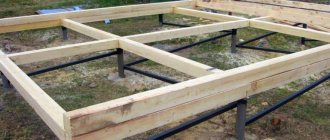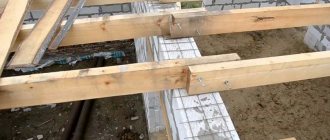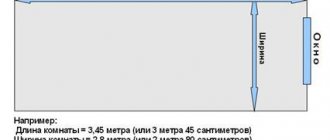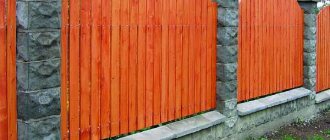The conditions for the construction of electrical overhead power lines (OHL), which include the distance between power transmission line supports, the boundaries of the minimum distance from other objects, are stipulated in the PUE and the STO standard (the same as SNiP). We offer a brief overview of the requirements that must be met when designing lines with a power of up to 1 kV.
The distance between the pillars depends on the voltage
Choosing an electric pole
The choice of material from which the support will be made is limited to three options: wood, reinforced concrete and metal.
Concrete pillar
Reinforced concrete supports are manufactured in industrial conditions, subject to technological parameters. High-quality poles will last a long time because they cannot be affected by aggressive components emitted into the atmosphere by industrial enterprises.
But a reinforced concrete electric pole has a significant drawback - its weight. It is very heavy, which makes it extremely difficult to install it yourself.
Metal supports
As a rule, they are used in the construction of high-voltage power lines. They consist of steel structures, are quite heavy and expensive.
Wooden electric pole
The name of the pole itself suggests that such electrical supports are made from a tree trunk. Such supports have a number of undeniable advantages over the two described above.
- Firstly, the cost of a wooden pole is much lower than a concrete one or one made of metal structures.
- Secondly, the weight of a wooden pole is much less, and lifting equipment is not required to install it.
- It is quite possible to make a wooden electric pole with your own hands.
- A properly prepared pillar treated with antiseptic and anti-flammable compounds can last no less than a concrete one. Namely, up to 40 years old.
Requirements for a wooden electric pole
To be used as a support, the pole must meet the following requirements:
- Wood - debarked coniferous tree trunks or oak. This treatment of the trunk allows you to preserve a layer of resin, which protects the tree from the influence of precipitation.
- The upper diameter of the trunk must be at least 12 cm for a voltage of 1.0 kilovolts, and 16 cm for 1.0-3.5 kilovolts.
Installation
The rules for installing reinforced concrete supports are determined by GOSTs and SNiPs and are the same for both Moscow and other regions of Russia.
The support is assembled on a flat area cleared of foreign objects. For heavy structures, 35 kV and more attract riggers.
Most often, installation is carried out using technological maps, which contain the sequence of operations, the necessary devices, and the layout of parts (crossbars, traverses, racks).
The procedure for assembling single-post supports made from vibrating racks for power lines up to 10 kV:
- In order to secure the traverse and the grounding descent, the top of the product is raised. The braces and traverses are put on the bolts, the nuts are installed and tightened.
- Before installing the insulators, polyethylene caps are filled. The insulators are mounted and the nuts are cored.
- At the end, a stencil poster is installed, where the year of installation and serial number are indicated.
The supports are lifted using a crane, helicopter or by building up. Before installation, the correct preparation of the foundation and pits is checked.
For different lines, supports of different types and sizes are used.
Overhead lines up to 1 kV
On overhead lines less than 1 kV, the following supports are installed:
- single-column free-standing unified intermediate;
- A-shaped end, anchor, corner;
- single-post with struts;
- prefabricated from vertical posts installed side by side.
It is possible to assemble and install reinforced concrete supports from vibrating racks, which are made to hang 2-4 radio wires and 2 to 9 overhead line wires.
Such structures have steel traverses. They are also used as lighting supports, placing lamps, brackets for branches, and cable sleeves on them.
Overhead lines up to 10 kV
For overhead lines from 6 to 10 kV, installation of single-column products with struts and intermediate, anchor, end and corner - A-shaped products is carried out.
Structures made from vibrating START poles have a traverse, which is made for hanging 3 wires up to 120 mm² made of aluminum.
On anchor and corner single-post supports with struts, steel traverses are placed for the wires of each phase.
On intermediate single-post supports made of centrifuged posts, apical pins and traverses made of wood 80*100 mm are placed.
Overhead line 35-500 kV
On lines of 35 kV and above, portal and single-column free-standing supports unified with guy wires are used.
Their structural parts are cable supports, traverses and pillars, which have asphalt-bitumen waterproofing.
To prevent moisture from entering the rack, plug covers are installed, the bottom of which is an additional way to increase the support area and the strength of the structure in the ground.
There are holes in the upper part of the post for attaching traverses. The grounding slope is laid inside the concrete.
The coupling fittings (brackets and earrings) are secured using rollers, clamps and special brackets installed in the holes provided in the cable stands and traverses. Metal cable supports are attached to the poles with clamps.
Portal single-column supports with metal traverses are installed on 330-500 kV power lines as intermediate ones.
For a 35-220 kV line, intermediate structures with cylindrical and conical posts, 2- or 1-circuit, free-standing single posts are used.
Anchor corner structures are made in the form of reinforced concrete products with guys for 35-110 kV overhead lines.
The distance at which power lines are installed to the fence
In the matter of building a house and equipping its territory, many issues are important. This includes the distance from the power line to the fence, which everyone who has started building a fence for their private plot should know about. The safety of those who come to the territory on vacation or permanently reside on the territory depends on the correct calculation of the distance from power lines to the fence of a private house.
Diagram with dimensions of the location of the fence from the power line
Important points
A person uses electricity all the time, be it at home, in the country or in the office. But few people delve into the fact that power lines not only supply a useful resource, but can also be harmful due to magnetic fields, and in case of failures they become unsafe for humans. It is imperative to adhere to the established rules, which indicate the required distance from the support to the fence of a residential private house for the following reasons:
- To preserve the health of building occupants.
- In order not to suffer from the effects of airborne electromagnetic fields that have a detrimental effect on the human brain.
- In the security zone of power lines, where the voltage level is especially dangerous for humans, the issue of locating residential buildings is especially acute. If the level of danger is off the charts, the area is fenced off with an industrial fence and a ban on construction in this area is put in place.
Power line protection zone diagram
Therefore, SNiP establishes distances from power lines to the fence of a house not just so that people do not receive fines for violations, but for the safety of the population of cities and villages.
The sanitary standards related to power lines clearly and in detail describe at what distance from power lines fences can be installed. This distance depends on the voltage level in the wires. In places of special tension, which are specially equipped, there are sanitary zones, near which it is prohibited to place fences and build residential buildings.
Safe distance from power lines
A requirement is established for the distance from the fence at the dacha to the place where the power line support is located, based on the voltage class.
Some owners of private plots turn to city or rural self-government bodies in order to obtain information about the voltage class in power lines located near their summer cottage.
Of course, not knowing how to determine the voltage level in the wires, it is better to do just that, so as not to unwittingly become a violator of SNiP requirements and endanger the residents of a private plot.
However, there is a method by which you can independently determine the voltage level in power poles.
Diagram of voltages in power lines of various types
If the voltage is very small, then it can be determined by counting the insulators.
How to increase your security level
Even having fully complied with all the norms and requirements regarding the distance of the fence from the poles through which electricity passes, houses built near power lines are still at risk in unforeseen situations and must protect their private sectors. This can be done in the following ways:
- Select a roof with grounding for the construction of the house,
- Install reinforcing mesh inside the wall structure. This solution will help reduce the risk of penetration of harmful electromagnetic waves into the living space,
- To increase the level of safety for home residents, fruit trees should be planted at a horizontal distance of at least 2 meters from power lines.
Minimum permissible distances from trees to power lines
Recommendations
The requirements in SNiP are prescribed primarily for the safety of people, and not to fulfill the wishes of self-government bodies. Therefore, you should not neglect safety rules, especially when it comes to electrical voltage.
It is worth paying maximum attention to calculations at what distance it is safe to install a fence from power lines. Only a properly installed fence will provide comfort and limit the residents of a private plot from troubles and danger.
Rules for placing supports
Line construction, modernization or reconstruction, in connection with which there is a need to install areas with additional supports, is carried out only with permission issued to the developer or customer by the relevant department.
- If it is necessary to install a new line, the developer must also justify the feasibility of such a solution before using other solutions, when, for example, a second circuit can be added, or the first one can be converted to a higher voltage.
Overhead line reconstruction
- The designs of overhead lines with voltages up to 20 kV must provide for the possibility of installing overhead equipment: electrical devices, fiber optic cables, automated energy consumption metering systems, protective relays and transmission information systems.
- When installing lines, supports must be placed in such a way that they do not impede vehicle and pedestrian traffic or make it difficult to enter the yard or enter the building.
This should not happen, even if the distance from power lines to residential buildings is maintained
- Poles should be placed in such a way as to prevent the possibility of running over them. And where they cannot be removed from the entrance to the yard or exit from the road, the support should be protected by a fence, as shown in the photo.
Protection of the support from collision
Information signs
If the distance between power line supports exceeds 250 meters, each of them must contain information printed at a height of 2.5-3 m. If the installation range is shorter, then the signs are placed through one support.
- Symbol of support.
- Its serial number.
- If there are more than two chains, then the chain number is indicated.
- Safe distance from power lines (size of security zone).
An example of marking is shown below:
Information on the support
The mystical meaning of the “devil’s gate”
Another undeniable advantage of reinforced concrete power line racks over wooden and iron racks is their high corrosion resistance when operating in fairly harsh environmental conditions.
Structurally, all electrical insulators differ in the methods of attachment to the supporting structure and cable fastening. The main task of this product is to prevent electrical discharges; for this purpose, they are made in the form of plates or rods with ribs. These ribs are needed so that the discharge develops at an angle to the field lines.
The entire range of building materials from one supplier. Don't waste time calling and searching. Wide range of high quality construction materials. Prompt delivery, convenience and special conditions - everything you need in one place.
By design, there are three main types of overhead line insulators:
- pin;
- suspended linear;
- support and passage.
When choosing lighting masts of a mobile or non-mobile type, it is necessary to take into account the financial and economic part, labor costs for transportation, delivery, installation and the aesthetic component.
According to the requirements of the PUE, the structure must contain only fire-resistant elements that can withstand exposure to an open flame for fifteen minutes. What then about the commonly found wooden poles? It’s simple; before installation, the wood is impregnated with a special compound to make it fire-resistant.
The installation of additional electric poles may be necessary in the private sector, especially if the wooden poles have become unusable. You've probably noticed rotting and rickety wood poles from which power lines run? Previously, only these were installed, but after the expiration of their service life, old samples should be replaced with new ones. It can be wooden, metal reinforced concrete or mixed: a wooden support on a concrete base.
Glass ones, although they are afraid of shocks, but to control their integrity a visual inspection is sufficient, which can be carried out without turning off the voltage. Currently, they are replacing ceramics in overhead power lines and as suspension insulators, including because they weigh less and are also cheaper to produce.
What associations arise when mentioning overhead power lines? Of course, the wires are stretched through the air from support to support or from pillar to post. Moreover, visually, the greater the span between the supports, the higher the wires are stretched, therefore, the higher the support itself should be. In fact, there is no direct relationship between the height of the support and the length of the span.
Pine and spruce are most often used as raw materials for the production of wooden poles. They are least susceptible to rot and insects, unlike other types of wood.
Instructions for installing electricity poles
Before starting the installation process, it is necessary to study the terrain features, which can significantly affect the quality and service life of electricity poles
So, pay attention to the factors:
- natural landscape - where the installation is taking place, for example, in a lowland;
- maximum wind load;
- optimal step between supports.
10.3. Gas industry
10.3.1. Hydrogen-cooled substations are provided with imported hydrogen and carbon dioxide. Own electrolysis installations are not being built at the substation.
10.3.2. The SC is supplied with hydrogen and carbon dioxide centrally from receivers. To receive and charge cylinders with hydrogen and carbon dioxide, a mechanized receiving and dispensing point (warehouse) is constructed at the substation, where ramps with cylinders and receivers are located in order to provide hydrogen for twenty-day operating consumption and a single filling of one CV with the largest volume.
The estimated daily consumption of hydrogen in one SC is assumed to be 5% of the total volume of gas in the machine body.
The minimum supply of carbon dioxide at the substation must be equal to three times the filling volume of one substation. The air for purging the compressor is taken from the substation air management system or from an independent compressor.
10.3.3. Hydrogen, carbon dioxide and compressed air are supplied to the SC through separate pipelines, laid openly on the same racks, with the pipelines arranged (from top to bottom): air-hydrogen-carbon dioxide.
The compressed air pipeline is connected to the SC with a flexible hose. It is allowed to lay carbon dioxide and hydrogen pipelines in cable ducts or trays, provided that seamless steel pipes are used.
Regulatory Requirements
Please note: the adopted document canceled the validity of the older PUE. The changes affect, among other things, the chapter “Electricity sewerage” that is relevant to us.
Let's pay attention to the most important points of the document in our case
General requirements for lines with voltage up to 1 kV
- When hanging any unprotected wires on supports, the distance from them to windows or balconies at maximum deviation should not be less than 1.5 meters.
- Above the carriageway, the wires are hung at a height of at least 6 meters, above the impassable part - at least 3.5 m.
The height of the wires above the roadway and pedestrian paths.
- The distance between the wires when spanning up to six meters must be at least 10 cm, when spanning over 6 meters - at least 15 cm.
- Entry into the building is carried out at a height of at least 2.75 m; in this case, an insulating pipe is used for entry, the shape of which prevents water from entering the house.
- The structures on which the conductors are installed are made of fireproof materials and must have a fire resistance rating of at least a quarter of an hour.
Comment: it would seem that this point puts an end to wooden pillars. But... no, a loophole remains: wood impregnated with a protective composition does not support combustion.
- The minimum distance from bare wires to a pipeline for any purpose is 1 meter. If the wire is insulated, the distance is not standardized.
- Insulators must be fireproof. Traditionally, porcelain and glass are used for this purpose.
The photo shows porcelain insulators.
Requirements for overhead lines with voltage up to 1 kV
The supports should not impede passage and passage, or block entrances to courtyards.
Where there is a possibility of being run over by a car, the support is protected from collision with it by a bumper or any other method.
The pole should be marked at a height of 2.5 - 3 meters. It indicates the serial number of the support, the width of the security zone and the telephone number of the line owner.
All metal structures are protected from corrosion. The method of protecting the PUE is not specified; Traditionally, painting is used for this.
The minimum wire cross-section for an overhead line is limited by its mechanical strength and is determined by the material.
| Wire type | Minimum cross-section, mm2 |
| Aluminum | 16 |
| Steel-aluminum | 10 |
| Bimetallic | 10 |
| Steel stranded | 25 |
It’s curious: for a single-wire steel wire, it’s not the cross-sectional area that is limited, but the diameter. It should not be less than 4 mm.
The branch from the nearest support is carried out only and exclusively with an insulated wire. The maximum branch length is 25 meters.
The input is made with an insulated wire.
To connect the wires, connecting clamps or welding are used. Single-wire wires can be connected by twisting followed by soldering; but you can’t butt weld them. In this case, a wire that differs in material or cross-section of the current-carrying core is connected only with clamps.
The minimum cross-section of the entrance to the house is also limited by the document; and in this case the cross-section is determined by the type of wire:
| The wire | Minimum section or diameter | |
| Span up to 10 meters | Span 10-25 meters | |
| Copper self-supporting | 4 mm2 | 6 mm2 |
| Steel or bimetallic | 3 mm | 4 mm |
| Aluminum | 16 mm2 | 16 mm2 |
Supports
What should the actual pillar be like?
For low-voltage lines, reinforced concrete, metal, solid wood and wooden poles with a concrete base can be used. All types of wood, except larch, must be impregnated with an antiseptic; Larch wood itself is extremely resistant to rotting.
Wood is the most affordable material for a pole.
When using a wooden support, its minimum diameter (at the top end) should be:
- For the main power supply line - 14 cm;
- For a branch to a house (in particular, for a pole installed on a site) - 12 cm.
Regarding the deepening of supports, the document is somewhat vague - “depending on local conditions.”
What should be the minimum distance from the pole to surrounding objects and communications?
| An object | Distance, meters |
| Water pipelines, heating mains, sewerage | 1 |
| Fire hydrants, water pumps, water wells | 2 |
| Power cables (for example, a wire from a well pump) without additional protection (insulating pipe) | 1 |
| Power cables in conduit | 0,5 |
2.5.87
The distances between overhead line wires, as well as between wires and cables, must be selected:
1) according to the operating conditions of wires (cables) in spans in accordance with 2.5.88-2.5.94;
2) according to permissible insulation distances: between wires in accordance with 2.5.126; between wires and support elements in accordance with 2.5.125;
3) according to the conditions of protection against lightning overvoltages in accordance with 2.5.120 and 2.5.121;
4) according to corona conditions and permissible levels of radio interference and acoustic noise in accordance with Chapter 1.3, 2.5.81, state standards, building codes and regulations.
The distances between wires, as well as between wires and cables, are selected according to the sag corresponding to the overall span; in this case, the sag of the cable should be no more than the sag of the wire.
In individual spans (no more than 10% of the total), obtained by placing supports and exceeding the overall spans by no more than 25%, an increase in the distances calculated for the overall span is not required.
For spans exceeding the overall dimensions by more than 25%, the distances between wires and between wires and cables should be checked in accordance with instructions 2.5.88-2.5.90, 2.5.92-2.5.95, 2.5.120 and 2.5.121, while it is allowed to ignore the requirements of the application tables.
If there are differences in sag, wire designs and insulator strings in different phases of overhead lines, the distances between the wires (cables) in the span must be additionally checked. The check is carried out under the most unfavorable static deviations at standard wind pressure directed perpendicular to the span axis of a given overhead line. In this case, the clear distances between wires or wires and cables for the conditions of the highest operating voltage must be no less than those specified in 2.5.125 and 2.5.126.
Power line security zone and the law
Magnetic waves emitted by power poles have a negative impact on people living near high-voltage structures. According to research, serious problems affect all organs. Based on this, experts have established the permissible distance at which residential buildings are allowed to be built.
In the city
If the site that is included in the security zone is owned by a private person, then a burden is imposed on the construction of buildings that provide for a long-term presence of people. Therefore, before you buy a plot to build a house near power lines, you need to inquire about a possible ban. The scope of the zone is determined by the organization of the electrical network.
Established standards for construction near power lines
The rules prohibit the installation of overhead power lines near open and crowded areas (sports grounds, swimming pools), over kindergartens and schools.
It is strictly prohibited to extend wires from poles over residential buildings. The site prepared for the construction of a country house or residential building must be located at a safe distance from power lines.
Sanitary protection zone
The distance between the pillars should be uniform. The height from the ground to the electrical cable should be:
- 3 meters between wires and rocky hill;
- 5 meters from the surface of a swamp or other source of water;
- 6 meters from the ground in a non-residential area;
- 7 meters from the soil surface in a residential area.
The distance to roads that run parallel to power lines should be five times the height of the pole.
To find out what distance from a residential building to a power line will be acceptable, you need to refer to existing standards. The safe distance from electric poles with a voltage of 110 kV will be about 20 meters; at a voltage of 500 kV – 30 meters; at a voltage of 750 kV - 40 meters; at a voltage of 1150 kV - 55 meters.
Power line support
To prevent radiation from high-voltage lines from having a harmful effect on the human body, it is recommended to choose a permanent place of residence at a distance of about one hundred meters.
An overhead cable can be laid underground. This action will increase the permissible distance by a whole meter. The method of underground cable wiring is an expensive proposition. But the result obtained will have a beneficial effect on the safety of living near power lines.
2.5.238
When crossing an overhead line with an underground communication cable and a power supply (or with an underground cable insert), the following requirements must be met:
1) the angle of intersection of overhead lines up to 500 kV with LS and LPV is not standardized, the angle of intersection of 750 kV overhead lines with LS and LPV should be as close as possible to 90°, but not less than 45°;
2) the distance from underground cables LS and LPV to the nearest ground electrode of an overhead line support with voltage up to 35 kV or its underground metal or reinforced concrete part must be at least:
in populated areas - 3 m;
in uninhabited areas - the distances given in Table 2.5.26.
Table 2.5.26 Shortest distances from underground cables LS (LPV) to the nearest ground electrode of the overhead line support and its underground part
| Equivalent earth resistivity, Ohm m | Shortest distance, m, at overhead line voltage, kV | ||
| Up to 35 | 110-500 | 750 | |
| Up to 100 | 10 | 10 | 15 |
| More than 100 to 500 | 15 | 25 | 25 |
| More than 500 to 1000 | 20 | 35 | 40 |
| More than 1000 | 30 | 50 | 50 |
The distance from underground LAN and LPV cables to the underground part of an ungrounded wooden support of an overhead line with voltage up to 35 kV must be at least:
in populated areas - 2 m; in cramped conditions, the specified distance can be reduced to 1 m, provided that the cable is laid in a polyethylene pipe at a length on both sides of the support of at least 3 m;
in uninhabited areas: 5 m – with an equivalent earth resistivity of up to 100 Ohm m; 10 m – with equivalent earth resistivity from 100 to 500 Ohm m; 15 m – with equivalent earth resistivity from 500 to 1000 Ohm m; 25 m – with an equivalent earth resistivity of more than 1000 Ohm m;
3) the distance from the underground cables of LAN and LPV to the nearest ground electrode of the overhead line support of 110 kV and above and its underground part must be no less than the values given in Table 2.5.26;
4) when laying an underground cable (cable insert) in steel pipes, or when covering it with a channel, an angle, or when laying it in a polyethylene pipe, closed on both sides from the ingress of earth, at a length equal to the distance between the overhead line wires plus 10 m with on each side from the outermost wires for overhead lines up to 500 kV and 15 m for overhead lines 750 kV, it is allowed to reduce the distances indicated in Table 2.5.26 to 5 m for overhead lines up to 500 kV and up to 10 m for 750 kV.
In this case, the metal covers of the cable should be connected to a pipe or other metal protective elements. This requirement does not apply to optical cables and cables with an external insulating hose, including those with a metal sheath. The metal covers of the cable insert must be grounded at the ends. When reducing the distances between the cable and the overhead line supports specified in Table 2.5.26, in addition to the given protection measures, it is necessary to install additional protection against lightning strikes by lining the supports with cables in accordance with the requirements of regulatory documentation for the protection of cables from lightning strikes;
5) instead of using a channel, angle or steel pipe, when constructing a new overhead line, it is allowed to use two steel cables with a cross-section of 70 mm, laid symmetrically at a distance of no more than 0.5 m from the cable and at a depth of 0.4 m. The cables must be extended on both sides at an angle of 45° to the route towards the overhead line support and grounded to a resistance of no more than 30 Ohms. The relationship between the length of the cable outlet and the grounding resistance must correspond to the values and given in Table 2.5.27;
Table 2.5.27 Resistance of grounding conductors when protecting LAN and LPV cables at the intersection with overhead lines
Work on the site, provided for by the technical specifications
It is advisable to trust the implementation of the power supply plan on a site for individual housing construction, as well as the scheme itself, to specialists if you want electrical communications to be as efficient and reliable as possible. But even in this case, it is better for the owner to understand the features of the electrical infrastructure in order to control the work and have confidence that everything is done correctly.
The main element of the system on the site is a pipe stand receiving device with a meter that will take into account electricity consumption. House construction, outbuildings and electrical appliances on the site are powered from it
It is extremely important to wisely select materials for the implementation of the scheme. Electricity is supplied through a cable; the air installation method is predominantly used
In this case, SIP 4 with a cross section of 16 mm3 is most often used. Its insulation is made of polyethylene, which is not destroyed by ultraviolet radiation, and its service life reaches a quarter of a century. Depending on what circuit is implemented on the site (single-phase or three-phase), a cable with either two or four cores is used.
In recent years, underground cable laying has been gaining popularity. In this case, it is better to choose a VVG copper cable with a cross-section of 10 mm3, or an aluminum AVBbShv cable with a cross-section of 16 mm3. If you use armored grades, they can be laid directly under the ground; conventional grades are pulled through a HDPE pipe. Entry into housing construction with underground installation is carried out in the same way as with the air method.
Pipe stand, its functions and installation methods
A pipe stand is a piece of pipe intended for fastening cables; wires are introduced into the area through it. An electrical panel is also installed on it. According to technical standards, the distance from the surface of the earth to the entry of electrical wires into the house must be at least 2.75 meters. Such parameters are necessary in order to avoid accidental contact. If the dimensions of the buildings cannot meet such requirements, a pipe stand is installed.
It is made of steel pipes, the diameter of which should be: when entering 2 wires - 20 mm, when entering 4 wires - 32 mm. No moisture should get into the pipe; therefore, its top should be bent 180 degrees. To avoid corrosion, it is advisable to cover the pipe stand with paint or bitumen. The gander can enter the building either through the roof or through the wall. If there are no buildings on the site yet, the pipe stand can be installed on the ground, subject to the technical conditions applicable in this case.
What components are required in an electrical panel?
Current technical standards require the presence of the following devices in the electrical panel: input packet, meter and RCD. All devices must comply with the parameters of the circuit features.
An RCD is a mandatory component, it is the safety of the house and household members, even if it operates only once during the period of operation, this will prevent serious problems associated with fires and electric shocks. The circuit breaker provides protection against short circuits and line overloads.
Padlock on the counter is a required attribute
Fastening the SIP cable to the pipe stand
To protect the lock mechanisms and allow easy opening, use wd40
A meter is required in the system to record electricity consumption; monthly payments are calculated based on its readings. These metering devices have many modifications, which are classified according to many criteria: principle of operation, accuracy class, connection features, number of measuring elements and other factors. Multi-tariff meters are in high demand because they allow significant savings on electricity bills.
Metering devices with a day/night tariff are equipped with a set of counting mechanisms, each of which operates at a strictly defined time of day. This is how accounting is formed using different algorithms. In the vast majority of cases, the multi-tariff accounting system generates significant savings for the family budget. Without a metering device, the power supply circuit cannot be put into operation.
The meters are reconciled and sealed by employees of the network company during inspection, before the actual connection of electricity. After which, acts on completion of work and connection of a new subscriber are drawn up.
Do not forget to install sockets in the panel in order to connect construction tools during the construction of the house
One of the seals on the shield
Ground wire is required
Estimate for pipe stand and prices for materials
What is it for
Correct determination of the span between lighting supports will allow you to achieve:
- creation of full-fledged lighting provision throughout the entire section of the roadway;
- high-quality lighting of sidewalks, squares and parks;
- creating conditions for the safe movement of vehicles on roads, as well as people along sidewalks and pedestrian crossings;
City street lighting
- reducing the level of illegal actions, which, according to statistics, are committed in poorly lit areas of streets, parks and squares;
- maintaining the city's infrastructure at the required level.
If an error has crept in at least somewhere, then the external lighting system will not be able to perform its direct functions at the proper level.
Why is removal from power lines necessary?
The distance from the fence to the power line, required by law, is not just a way to ensure the maintenance and operation of high-voltage lines. The Moscow government plans to transfer such networks to underground ones, because constant exposure to an electromagnetic field is extremely harmful for people living in such conditions.
This is not only a danger of oncological processes, but also the possibility of developing endocrine, immune and nervous pathologies. Even in a village where the number of people per square meter is much smaller. km, the state requires ensuring the health safety of its citizens by establishing sanitary and protective standards.
They regulate not only the security areas in the electromagnetic field zone, but also the distances from the wires to the roadway (at least 6 m from the pedestrian path (starting from 3.5 m) and the height of the branch near the house (starting from 2 m 75 cm)) . Scientific studies have established the influence of e/m fields on reproductive function in men and the possibility of causing miscarriages in women.
If rural or urban areas are taken into account, then the distance standards are still aimed at:
preventing fire in the fence of a residential building or utility room in the event of a probable accident that no one can foresee; take the maximum possible precautions regarding the health of people living in an area located in close proximity to power lines (no matter what kind of area it is, even if it is a country house where people do not live permanently); to prevent possible consequences from weather conditions that caused a fall, destruction of the structure or release of accumulated charge into the atmosphere.
In order to increase their security, many owners build a roof with grounding, lay reinforcement structures in the walls and specially plant fruit trees at a safe distance.
However, all this is not enough if the power line is located at an insufficient distance from various buildings. And the necessary standards can be easily determined by the appearance of the structures or by making inquiries with the relevant authorities. But in any case, the minimum distance is at least 10 m.
What additional methods of protection are there?
To increase protection from the harmful effects of fields generated by power lines, additional protection options are provided. These include:
- Shielding devices for voltages from 10 kV.
- Roofs made from metal tiles or corrugated sheets should be grounded. The roof is grounded only if the distance from it to the power lines is small.
- The presence of reinforcing mesh - the kind that is laid in reinforced concrete walls.
At present, the harmful effects of power lines on human health have not been officially confirmed. Such studies have not been conducted in Russia. But this does not mean that the problem does not exist.
Possible damage zone in an accident
According to the observations of foreign scientists, a huge number of people who live or work in close proximity to high-voltage structures experience their negative influence, they often feel unwell. In addition, the risk of nervous ailments and the development of cancer increases.
How to install correctly
After you decide on the choice of material, you need to calculate at what distance the poles will be from each other, and how many of them you will need in general to provide electricity to the entire area.
For this, there are standards established by electrical engineers. This takes into account the length of the pole and what wire will be used.
From the calculations you can find out how many meters there should be between the pillars. After which, you can begin drilling wells for further installation of pillars in them.
Also, if you need to deviate from the course of the line and, for example, “power” a barn, it is not necessary to install all the same pillars on the way to it. There are small intermediate racks for these purposes. They do not require a support post due to their small size. They can also be used for street lighting in a summer cottage.
Please note: you should not connect the site to the main line yourself, even if you know how to handle electricity! If you connect on your own, you will definitely be fined! Therefore, it is better to obey the demands of the authorities. And then your home will be light and cozy
How to place a support under power lines manually, see the following video:
If you have purchased a country house or are about to start building it, then sooner or later you will be faced with the question of connecting to the electrical network. Often, in connection with this, there is a need to install a power line support near the site. In general, the installation of poles should be carried out by government organizations and this work should be done for free, but in practice everything is not so smooth, and you will have to wait several years. Special organizations can solve this problem for some money.
When hiring specialists, there is no need to delve into the intricacies of the work, but you still need to know certain information. Electricity poles come in three types:
- wooden supports are the cheapest, but not particularly durable;
- reinforced concrete pillars are the most common in use;
- iron power line supports are the most expensive.
Which pole to choose depends on the climatic conditions and the power of the energy consumer.
The approximate cost of installing electricity poles is as follows:
- installation of one pole - 30-35 thousand rubles;
- five pillars - 100 - 120 thousand rubles;
- ten supports – 170 thousand and above.
Let's figure out how these amounts are obtained. Firstly, the cost of installation also includes the price of the pole itself, and secondly, all installation features are taken into account.
Basic principles of street lighting
To provide streets with light at night, poles have been used for many years. Over all these years, the most used materials for their manufacture have been wood, concrete, iron and reinforced concrete. This is due to their strength and longevity, especially for reinforced concrete. Many different areas of both residential and non-residential areas of a settlement need constant light at night, in particular:
- street sidewalks and pedestrian paths;
- carriageways for cars and highways;
- territories where various institutions are located;
- gas stations;
- car parks, etc.
High-quality street lighting Although the distance between lighting poles is the most important point during installation, it is still necessary to know and understand the essence and purpose of the structures for the lamps themselves. It has two components:
- The main part of the support is a pillar, which can vary in height. This is due to its function and location. Usually, when installing them in a village or city, the height is selected in such a way that the incident light forms peculiar cones on the ground that must intersect.
- A source that reproduces the luminous flux. This equipment is installed on top of lighting poles and can be of different shapes, wattages, etc. This factor depends on the location of the lighting line. For example, when arranging the illumination of highways, the use of lamps with powerful lamps is required, which, accordingly, increases the size of the lighting device itself. To illuminate recreation parks, squares and public gardens, you can use poles of shorter height and decorative light sources.
Types of poles for street lighting Very often, poles with lanterns perform not only a lighting function, but are also supports for holding various wires and power lines. In this case, the distance between them can be increased.
Package of documents
To install and connect power line supports, the owner needs to collect the following documents:
- passport;
- document of ownership of the site;
- TIN;
- a list of electrical devices that will be constantly used by the owners (indicating the power);
- calculation of the network load;
- technical plan of the site indicating the nearest power transmission line supports and the proposed locations of new poles.
IMPORTANT! If there are communications (gas or pipelines, sewerage) on the ground near the future location of the supports, they must be displayed on the technical plan.
general information
The distance between two adjacent lighting poles is called the span. Its size depends on such main factors as:
- type of illuminated area;
- height of supports;
- power of light sources;
- their type and configuration;
- location of supports relative to the illuminated area;
- terrain features.
For example, if modern street lighting systems use LED technologies, then during the calculation an adjustment is made for power consumption and intensity of emitted light. These parameters differ if gas-discharge lamps and incandescent lamps are used. In particular, LED light sources have higher efficiency. Roughly speaking, they provide more light while consuming less electricity.
As for the type of illuminated area and the distance between the supports, in this regard it is calculated based on the lighting requirements. You can find them in document CH 541-82. Instructions for designing outdoor lighting for cities, towns and rural settlements. For example, busy roads require more intense lighting than local streets with low traffic and people moving around.
Mains voltage
The distance between the supports is determined depending on the voltage in the wires they carry:
- 0.4–1 kV – distance within 30–75 m;
- 10 kV – spans up to 200 m;
- 220 kV – distance between supports up to 400 m;
- over 330 kV - supports can be located from each other at a maximum distance of 700 m.
The wires are suspended in parallel on insulators at a height that also depends on the voltage. If it is up to 1000 V, then the line is fixed at a height of 7 m.
The permissible sag and the distance to the bottom point are also determined depending on the voltage. In cities, towns of individual housing construction and SNT, the lowest sagging point should be higher than 6 m from the ground.
Other publications under the heading “Engineering systems for a country house. Gas. Electricity."
Question: Please tell me, at what distance from a power line pole can I dig a ditch 1-1.5 m wide, 6 m wide, so that the pole does not fall legally? In which document are the distances established? Answer: By Decree of the Government of the Russian Federation No. 160 dated February 24, 2009, “Porya.
Question: The house has 58m2. One toilet, washbasin, sink and washing machine. All this goes into the cesspool with a pipe with a diameter of 100 mm. There is a 1.5 meter pipe above it. Do I need to install a drain pipe? If not, is it necessary to install a water seal through the tee or something like that? Answer: Most.
Question: Will a 16-meter-deep sand well become swamped if it is used only in summer? Answer: It will. Your well “on the sand” extracts water from the upper layers of the earth - from sandy horizons. Such wells are drilled to a depth of 15-45 meters. The most important advantage of s.











